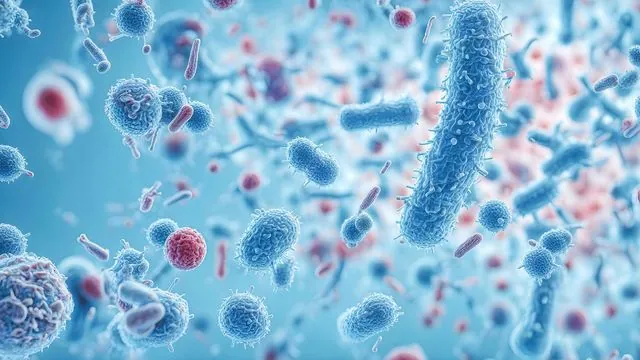
A Game-Changer in Infection Treatment: Disrupting Bacterial Movement to Combat Diseases
2025-04-02
Author: Mei
Introduction
In a groundbreaking study, researchers have unveiled a revolutionary method to combat persistent infections, such as Lyme disease and syphilis, by targeting the bacterial "motor" responsible for their mobility. This innovative approach could reshape how we treat infections, especially amid growing fears of antibiotic-resistant bacteria.
Research Findings
The research, published in the journal ACS Chemical Biology, signifies a crucial step forward in the fight against diseases caused by spirochetes—cork-screw shaped bacteria notorious for their invasiveness. “Many bacteria need mobility to infect their host organisms, including humans,” emphasized Brian Crane, director of the Weill Institute for Cell and Molecular Biology. He noted how spirochetes use their motility to move from host to host, navigate through tissues, and evade the immune system.
Mechanism of Action
The study, funded by the National Institutes of Health and the Bay Area Lyme Foundation, explored the bacteria's movement mechanisms and showed that disrupting their motility significantly decreases their ability to spread and cause infections. The spirochetes utilize a unique propeller-like motor, shielded by a membrane from the host's immune response, which enables them to move through tissues.
One key element to their motility is the flagella—long, whip-like structures that act as propellers. The researchers found that these flagella are connected to the movement machinery by a hook constructed from protein subunits. This hook relies on specific molecular connections called lysinoalanine (LAL) cross-links to function effectively. Disruption of these cross-links results in impaired movement, dramatically reducing the bacteria's ability to infect the host.
Potential Drug Candidates
In testing, the researchers screened existing clinically approved drugs and identified three candidates—hexachlorophene, triclosan, and dichlorophene—that inhibit LAL formation. Their experiments showed that hexachlorophene notably curtailed the movement of spirochetes associated with gum disease, indicating that targeting bacterial motility could serve as a potent new strategy for infection control.
Broader Implications
Spirochetes are not only linked to diseases like Lyme disease and syphilis but also to leptospirosis, which can lead to severe health issues including kidney damage. These bacteria can infiltrate nearly every tissue in the human body, even crossing the blood-brain barrier. Many of these infections pose diagnostic challenges and can be resistant to standard antibiotic treatments.
Advancement Over Traditional Antibiotics
The researchers advocate that this targeted approach vastly improves upon traditional antibiotics, which often indiscriminately attack both harmful and beneficial bacteria. “Our method specifically targets the LAL formation in flagella within pathogenic spirochetes,” explained Michael Lynch, the study’s first author. This specificity minimizes collateral damage to beneficial gut microbiota, representing a substantial advantage over conventional treatments.
Addressing Antibiotic Resistance
With the rise of antibiotic-resistant strains presenting serious public health threats, innovative antimicrobial strategies are urgently needed. By focusing on bacterial motility, this research opens up potential new avenues for antibiotic development and enhances our ability to combat diseases linked to motile bacteria like spirochetes.
Conclusion
“This study is the first to target LAL cross-links in the flagella hook as an antimicrobial strategy,” Crane noted. “By highlighting motility as a key factor in the pathogenicity of spirochetes, we establish a solid foundation for future antimicrobial therapeutic innovations.
In conclusion, the disruption of bacterial movement appears to be a promising frontier in the search for effective infection therapies, which could lead to advances in healthcare that save millions of lives. The implications of this research extend beyond just spirochetes, potentially paving the way for novel treatments against a variety of pathogenic bacteria resistant to conventional therapies. As scientific innovation continues to evolve, the hope is that we can stay one step ahead in the ongoing battle against antibiotic resistance.



 Brasil (PT)
Brasil (PT)
 Canada (EN)
Canada (EN)
 Chile (ES)
Chile (ES)
 Česko (CS)
Česko (CS)
 대한민국 (KO)
대한민국 (KO)
 España (ES)
España (ES)
 France (FR)
France (FR)
 Hong Kong (EN)
Hong Kong (EN)
 Italia (IT)
Italia (IT)
 日本 (JA)
日本 (JA)
 Magyarország (HU)
Magyarország (HU)
 Norge (NO)
Norge (NO)
 Polska (PL)
Polska (PL)
 Schweiz (DE)
Schweiz (DE)
 Singapore (EN)
Singapore (EN)
 Sverige (SV)
Sverige (SV)
 Suomi (FI)
Suomi (FI)
 Türkiye (TR)
Türkiye (TR)
 الإمارات العربية المتحدة (AR)
الإمارات العربية المتحدة (AR)